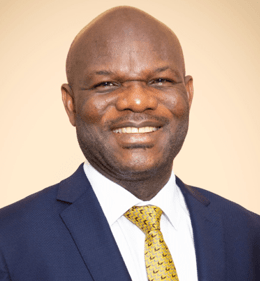By Theophilus AYITEY ADJIN
…Developing bank risk universe for accountability and performance
Learning from Eden – identifying and naming animals
About three decades ago, as a mining engineering undergraduate, I attended a wedding at the Great Hall of the University of Science and Technology, Kumasi. The couple were dear friends with whom I shared a passion for music and drama in Scripture Union, Tarkwa Town Fellowship.
The groom was both my mineral processing lecturer and drama director, and the bride a singer. Back then, I played the bass guitar and engaged in dramatized poetry and acting. At the wedding, a group named Oasis performed a beautiful skit in honour of the couple.
It depicted the biblical Adam and Eve—their life, love and work, before sin marred everything. One scene left an impression on me – Adam naming the animals. This often comes to mind when I think of the universe of risks in banking, and how to categorise, name and manage them.
Adam was the first person to be created, and the first man to see and … touch a woman. Imagine all these, before the advent of tiredness and headaches as excuses, in a garden filled with rich scents of lavender, jasmine, thyme, and mint.
It is hard not to envy Adam a little. When Adam saw Eve for the first time, he said “This is bone of my bones, and flesh of my flesh.” Pause for a second – what do those words mean? In my opinion, they make Adam the first lyricist and poet. This may explain why men often wax lyrical to women they admire. Let me not digress too far.
What is most relevant to this article is Adam’s work. He was the first human to have a job – to work in and take care of a garden. He named “each living creature,” including “all the livestock, the birds in the sky, and all the wild animals.” It is likely that Adam undertook this task by first grouping the animals into broad categories before naming them individually.
This exercise, in a sense, was the earliest form of taxonomy—the system of classifying and organizing living organisms. Taxonomy extends beyond biology to other fields, including risk management. In this piece, I will name some broad bank risks, with a view to enhance understanding of bank risk management, accountability, and performance management.
Looking at banking – identifying and naming risks
Banking appears simple: take deposits from customers who can part with their money for a while and lend them to others for a period. The customers may be individuals, corporates, or governments.
This process hides inherent uncertainties – risks — that can easily get out of control. Anyone who has anything to do with banking must understand that banking is a risk management exercise. Therefore, to be a credible banker, one must be a risk manager. Let us look at some key risks that banks must manage.
To attract deposits, banks pay interest to depositors. Then, they earn income primarily by charging interest on loans and overdrafts. For a bank to remain profitable, the gap between these two interest rates must be sufficient to cover expenses relating to remuneration, technology, bad loans, and the like.
This is why your bank offers relatively low interest rates on your deposits but charges higher interest rates on loans and overdrafts. However, changes in the economy, competition among banks, and fluctuating interest rates can shrink a bank’s interest income, and even result in losses. Banks do not control these variables, and that is what is known as interest rate risk. Do you see how banking can be risky?
Lending is associated with the risk of default. Anyone who has lent money before, even to a friend or family member, knows that things do not always go as planned. Borrowers can miss payment either willingly or due to unforeseen circumstances. This is what we call credit risk.
If the borrower happens to be a government, we call it sovereign risk. If I may, do you think Ghana’s sovereign risk is high or low? OK – keep your answer. Things can worsen even further when a bank gives too much credit to a single borrower or economic sector.
This is concentration risk. Here is a good point to remember the saying “Don’t put all your eggs in one basket.” When defaults occur, they can constrain a bank’s ability to provide further loans, destabilize its earnings, and impair its capacity to meet obligations. This introduces earnings risk, which jeopardizes a bank’s ability to cover costs or pay dividends.
Banks must also have sufficient funds to enable them to promptly honour withdrawal requests from customers. Not doing so results in liquidity risk. If I liken liquidity to the breath of a living creature, then I will say when choosing a bank, choose one that “breathes” well. You get the idea right?
In today’s interconnected financial world, customers and banks often transact in foreign currencies. When deposits and loans are in foreign currencies, their values fluctuate with exchange rates. Unfavorable shifts in exchange rates, when improperly managed, can result in significant losses. This is known as foreign exchange risk.
There is a category of risks that feels like a household grocery list. This is operational risk. It includes risks related to people, processes, systems, and external factors. Without people there would be no banks, but people come with their challenges: errors, misconduct, fraud, skills gaps, and underperformance. Processes, too, can fail. Years ago, I was stunned to learn of a bank where a loan was approved and disbursed without the involvement of the credit team.
I am yet to recover from my shock. Then there are systems, which can malfunction or fall prey to fraudsters. The increase in digital platforms has ushered in cybersecurity risk, as bad actors attempt to steal, attack, or compromise bank systems and data.
Interbank relationships cast another layer of complexity. When one bank fails, it can affect another to shock the entire banking sector and pose a systemic risk to the economy. This is one of the reasons why regulations are in place to protect the entire system. The failure to adhere to regulations can result in fines, reputational damage, and the potential revocation of a bank’s license. This is regulatory risk.
Additionally, the impact of banking activities on society and the environment has given rise to ESG risks. Neglecting environmental, social, and governance issues can spell trouble for a bank’s long-term sustainability.
In their lending and investment considerations, banks must consider environmental factors like climate change and social issues like lending responsibly and promoting equity. With so many moving parts, banks often rely on models to manage risks, guide operations, and comply with regulations. However, these models can fail due to flawed algorithms or assumptions, introducing model risk.
Bank risks have implications – beyond naming to managing.
As you may see by now, banking is more complex than it appears. As a customer, you should be concerned about the uncertainties that could harm your household and business.
Before entrusting a bank with significant business, assess its risk management practices and control environment. Seek assurance that the bank adheres to all relevant regulations and directives. This you can verify from the central bank and other credible sources. Form an opinion about its financial stability.
Pay attention to customer reviews and check the media for any adverse reportage. Probe the bank for responsive customer service, and transparency in their product terms. Evaluate how it manages cyber security issues and look at its record for managing past crises and resilience challenges.
As a professional it is important to recognise the real value in identifying and categorising risks to improve performance. Each category of risk must have an assigned owner. This individual should serve as the subject matter expert, collaborating with the risk management team and other stakeholders to strengthen risk management practices and boost overall performance.
This approach is achievable, but it is not without its challenges. We operate in an imperfect world, unlike Adam, who labored and loved in a paradise without headaches or exhaustion. It is difficult not to envy Adam a little.
Theophilus is the Chief Risk Officer of GCB Bank PLC. He is a Chartered Banker and a member of the Institute of Directors – Ghana. He is a trained Mining Engineer and a Fellow of the West African Institute of Mining, Metallurgy and Petroleum.










